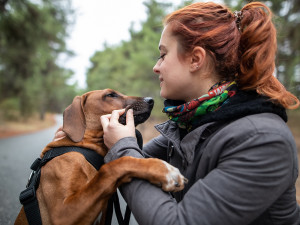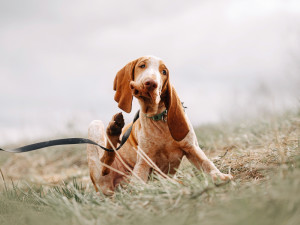Do Essential Oils Pass the Smell Test?
A psychologist explains how stimulating scents can influence a dog’s behavior.

Share Article
It’s a beautiful summer day. You and your dog are walking near a patch of grass when they stop dead, then sniff and keep sniffing. Gently, you tug on the leash, but — muzzle buried in the turf — they brace themselves and continue their nosework.
Scent is extremely important to dogs, much more so than to humans. All dogs have smart noses. In fact, MRI studies show that when a dog recognizes the smell of a familiar human, the caudate nucleus in her brain lights up, signaling a happy event. For the average dog, a small pile of foliage contains a world of information. Though the canine brain is about one-tenth the size of a human brain, its smell center is 40 times larger. We have roughly five to six million scent receptors, a fraction of the 125 to 300 million available to our canine companions.
Firstly, This Is How Dog Noses Work
Their moist noses are cute, but there’s function behind that soft form. The mucus on a dog’s nose helps capture scent particles. When a dog’s nose is dry, they may lick it to improve reception. Dogs can also wiggle their nostrils independently, thereby detecting the direction of odors.
Despite the fact that the olfactory system is an ancient neurological pathway, we still do not completely understand how it works, either in ourselves or in our dogs. However, enough studies have shown it is critical to the survival of species across the animal kingdom — especially dogs.

How Scents Influence Human Behavior
Though we may not understand it, most of us are aware that scent can influence behavior. In the realm of human holistic treatments, the use of essential oils and herbal fragrances has become increasingly trendy, and yoga teachers will sometimes use aromatic oils during classes.
Exposure to certain herbal or spice scents has been shown to have positive effects on humans. For example, Mark Moss and Lorraine Oliver, working at the Brain Performance and Nutrition Research Centre at Northumbria University in the UK, designed an experiment to investigate the pharmacology of 1,8-cineole, one of the main components of rosemary.
After exposing 20 human subjects to varying levels of 1,8-cineole, the investigators tested their cognitive performance. Speed and accuracy test results showed that the concentration of 1,8-cineole in the blood was related to an individual’s cognitive performance: higher concentrations resulted in increased speed and accuracy. If scent can have positive effects on olfactory challenged humans, it might be expected to have an even more pronounced effect on dogs.
How Scents Influence Dog Behavior
While research on canines is limited, a studyopens in new tab done at the University of Belfast explored the influence of four types of olfactory stimulation (lavender, chamomileopens in new tab, rosemary and peppermint) on the behavior of 55 dogs housed in a rescue shelter. The control condition used no odors other than those arising naturally from the dogs’ environment (e.g., odors from disinfectants and other animals). Using diffusions of essential oils and allowing two days between stimulants, the dogs were exposed to the scents four hours a day for five days.
According to the study, dogs exposed to lavender and chamomile spent more time resting and less time moving than with other olfactory stimuli used in the experiment. These odorants were also found to reduce barking and vocalization in caged animals. On the other hand, fragrances such as rosemary and peppermint were found to encourage significantly more standing, moving, and vocalizing.
How Scent Enrichment Helps Shelter Dogs
Shelters are safe but sterile environments, and, recognizing that as an issue, some have looked for ways to enrich those environments for their animals. With that in mind, an increasing number are introducing scents. For example, the Humane Society of Miami used a scent enrichment program, which incorporated essential oils such as lavender and vanilla.
McKamey Animal Center, located in Chattanooga, TN, is among the few that have worked with scent enrichment for several years, according to Morag Greaney, the center’s former adoption and foster supervisor. According to Greaney, the scents — which include lavender, vanilla, and rosemary — are changed every day. The essential oil was mixed with water, then sprayed on the ground outside the dog kennels using nonaerosol methods. While there wasn’t an immediate reaction, staff observed that the animals tended to be calmer and more settled the following day. Greaney believes that it is not just a particular scent that makes a difference (although she does find that lavender has a calming effectopens in new tab), but the variety that helps stimulate the dogs’ brains.
The center, which handles upwards of 200 animals, hosts a number of different breeds — Huskies, Labradors, German Shepherds, and Pit Bull-type dogs — among them. While the center hasn’t conducted any formal studies to determine if different breeds are affected differently by the scents, its behavior-assessment team uses lavender to help relax new animals prior to evaluation.
The results of these small studies may be promising to help reduce the stress of shelter animals, but more research is needed on the safety of using essential oils more broadly with pets.
Should You Use Essential Oils at Home?
Scent enrichment, in tandem with other stress relief techniques, may work at home with guidance from your veterinarian. “I would absolutely recommend that dog owners use scents with their animals,” says Greaney. However, she cautioned that people should first do some preliminary research and check with their veterinarian to avoid any possible detrimental effects—that’s because many essential oils are toxic to pets. What may be safe for dogs can be fatal for cats and vice versa, while others are poisonous to both species.
According to ASPCAopens in new tab Animal Poison Control Center (APCC), “Using an oil diffuser for a short time period in a secured area— one that your dog or cat cannot access—is not likely to be an issue.” The ASPCA also has a helpful list of toxic and non-toxic plantsopens in new tab and pro tipsopens in new tab on using essential oils, which you can refer to alongside your veterinarian to determine if any essential oils could benefit your dog.
Disclaimer alert: This article is here to share information, but more research needs to be done. So, don’t take this as medical advice. Talk things over with your vet when making decisions, and use your best judgment.
Sheldon Siporin, PhD
Sheldon Siporin, PhD, is a psychology professor at Pace University in New York City and has volunteered in several Manhattan animal shelters.
Related articles
![Redhaired woman holding her Rhodesian ridgeback dog]()
How to Treat Epilepsy in Your Dog Holistically
Watching your pet suffer a seizure can make you feel helpless. We asked three veterinarians to weigh in on natural remedies that show promise.
![Jasmine Hemsley standing with her two dogs]()
Chopping It Up with Wellness Guru Jasmine Hemsley, Julie, Arji & Mr. Bims
“They gather around when they see us setting up a sound bath — they can sense a calming energy and want chill-out time with us.”
![Dog sitting in a tent surrounded by candles and crystals]()
Alternative Therapies Can Zen Out Your Pet, Too
Wellness treatments like acupuncture, Reiki, and sound baths are helping pets heal and bond with their parents.
![Calico cat sniffing wooden bamboo essential oil diffuser]()
Why Essential Oils and Pets Don’t Mix
How to keep your DIY spa pet-friendly.
![puppy scratching fleas, get rid of fleas on dogs]()
How to Get Rid of Fleas — Proven Home Remedies
You can stop your home from becoming a literal flea circus.






